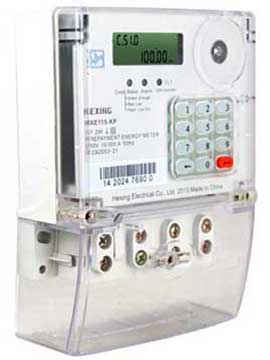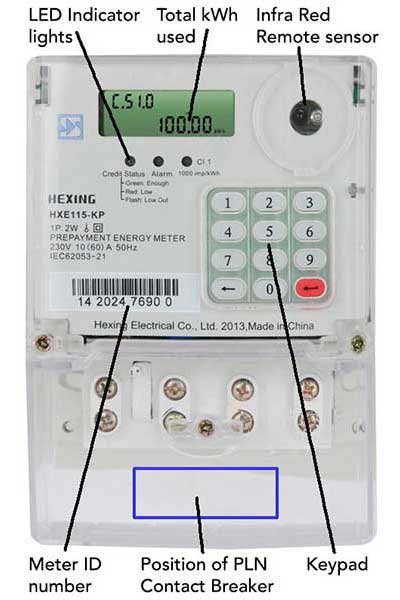Prepaid Electricity Meters
Prepaid Electricity Meters
Here we look at prepaid electricity meters and compare them with post paid meters, how we read and operate them, how we know how much electricity is left and how we recharge the electricity.
We also look at the advantages and disadvantages of prepaid digital meters and some does and don'ts in using them.
The Introduction of Prepaid Electricity Meters

All around the world we see the introduction of prepaid "pulsa" electric meters, a move which has provided electricity companies with all sorts of benefits.
No longer does a meter reader have to come around to your house to read your meter. No longer will you get approximated bills because the meter reader couldn't get in. No more crowds of people at the electricity office waiting to pay their bills.
More importantly for the electricity company, prepaid meters mean no more debts from people who haven't paid their bills. No wonder they are so keen to get as many people as possible onto the new meters as soon as possible.
Getting a new connection or upgrading one to a higher tariff is a lot simpler than it used to be.
Price schedules are available at electricty company offices listing how much it costs to upgrade your power.
Upgrading your power.
For increasing your electrical supply go to: www.mrfixitbali.com/electrical/electricity-supply/increasing-your-power-supply.html
The Cost of Electricity
In Indonesia the price we are charged for electricity changes each month according to the price of oil, in February 2023 the price was Rp1,444.70 per kWh. For an explanation of this see the article here: www.mrfixitbali.com/electrical/electricity-supply/electricity-cost-Indonesia.html For prepaid meters the price is the same as for billed meters however there is one important difference.
We said last week that if you have a post paid meter you have to pay a minimum charge (see article here www.mrfixitbali.com/electrical/electricity-supply/electricity-cost-Indonesia.html) but if you have a prepaid meter there is no minimal charge - you only pay for what you use. If the house is empty you don't have to pay anything, and your supply will not be disconnected.
With all electricity supplies we are charged an additional 5% on the bill to pay for street lighting. This means that when you buy Rp100,000 of electricity the first thing that happens is the additional 5% is removed.
So our calculation is as follows:
Rp100,000 less the 5% tax which means we are left with Rp95,238 (no not Rp95,000 - remember Rp100,000 is 100% plus 5%) to pay for the power. Rp95,238 divided by Rp1,364.86 gives us 65.92 kWh of electricity.
Advantages of prepaid meters.
- You only pay for what you use, there is no minimum charge.
- You can pay through many different sales points. No more long queues at PLN offices
- There is no meter reader wanting to get into your property to read the meter.
- You won't get estimated bills because PLN couldn't get in to read the meter.
- The power supply will not be disconnected when a bill is not paid - there is no bill so you can go away for 3 months safe in the knowledge that the power will still be connected when you come back.
- You can preload as much power as you like.
- If you are leasing your house to a tenant out there are no difficulties or arguments about the electricity, if your tenant doesn't pay they don't have power and your supply cannot be cut off.
Disadvantages
- You have to pay "up front" buying the power before you use it.
- You have to keep an eye on the meter to make sure it doesn't run out. You do get warnings and we will look at that shortly.
- It is harder to keep track of the electricity cost per month.
As we can see the advantages far outweigh the disadvantages both for PLN and for the consumer.
So let us have a look at prepaid meters. There are several brands that PLN uses, they are Actaris, Landis GYR, Star, Hexing, Conlog, Glomet and Itron. The design varies between them but generally they are similar.

Near the top is a digital display which displays such things as the number of kWh (kilowatt hours) of power that has flowed through the meter and a 4 digit OBIS (Object Identification System) code which is used by PLN technicians. Below the display are three LED lights (we'll come to them in a minute). In the central section is a numerical keypad which is used to add "pulsa" to the meter. There may be a circular area that contains an infra red remote connector. There is also a barcode sticker that contains the meter's 11 digit identification number. At the bottom is a blue contact breaker, this is the PLN master switch.
How do we know how much power we have left?
As we said there are three small lights on the meter just below the display.
The first LED is marked "Credit Status" and tells you how much power you have remaining.
If you have plenty of power remaining this will show a continuous green light. As the amount of power left diminishes the light may change to yellow to warn you that there is not a lot of power left. When the power is almost finished the light will turn to red. When the amount of power remaining becomes critical the red light will start to flash and a buzzer or beeper will start to sound.
If you live with an empty house next door, as I do, you will know this warning sound well for it drives an irrepressible impulse to get up in the middle of the night, take hold of a suitable implement (such as a sledge hammer) and relieve your frustrations by cathartically modifying the condition of the afforementioned device reducing it to mere fragments of its former glory.
The second LED light indicates if the meter has been tampered with.
The third LED light is marked "1000 imp/kWh" and shows a flashing red light. This light is a replacement for the revolving wheel on electricity meters of old. "imp" is short for impressions (flashes) and every time the light flashes it means a watt of electricity has passed through the meter, a thousand flashes and a kilowatt has passed. Just as the turning wheel on the old meters speeds up on old meters, the rate of flashing increases as the amount of power being consumed increases.
This flashing light can be used by smart equipment to monitor and record your power usage for management purposes. However, since such smart equipment is as rare as meaningful information in an important referendum, this is useless information that merely provides an uninteresting diversion to our discourse or perhaps some useful material for your local quizmaster.
How to add power to a prepaid meter.
You can buy electricity refill vouchers in denominations of Rp20,000; Rp50,000; Rp100,000; Rp250,000; Rp500,000; and Rp1,000,000. These are available from payment counters in partnering banks BRI, BNI, BCA, Mandiri, NISP, Danamon, Bukopin, BPRKS and other online outlets. You can also buy them through ATMs, SMS and internet banking.
You will be asked for the 11 digit identification number of the meter which is on barcode label on the front of the meter, the number will be something like 14 2024 7690 0.
The voucher will give you a 20 digit number. Enter this number using the keypad on the front of the meter, the number you enter will be displayed on the LCD screen. If you make a mistake you can press the backspace key to delete digits. Once you have entered and checked the token number press the enter key to activate the electricity. If the correct token number has been entered the LCD screen should display "benar" (correct or accept) and the power is added. If you entered an incorrect number the screen will display "gagal" (fail or reject) and you will have to start again.
Do's and Don'ts
- Do not break any of the seals that PLN use to seal their meters.
- Make sure your meter is in a dry location away from the weather.
- Do not let your meter get wet.
- Do not use sharp objects or wet cloths to clean your meter.
Phil Wilson
Copyright © Phil Wilson
This article, or any part of it, cannot be copied or reproduced without permission from the copyright owner.
